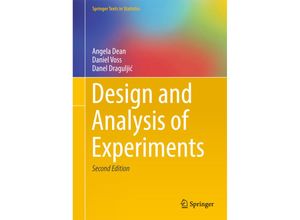This textbook takes a strategic approach to the broad-reaching subject of experimental design
by identifying the objectives behind an experiment and teaching practical considerations that
govern design and implementation concepts that serve as the basis for the analytical
techniques covered. Rather than a collection of miscellaneous approaches chapters build on the
planning running and analyzing of simple experiments in an approach that results from decades
of teaching the subject. In most experiments the procedures can be reproduced by readers thus
giving them a broad exposure to experiments that are simple enough to be followed through their
entire course. Outlines of student and published experiments appear throughout the text and as
exercises at the end of the chapters. The authors develop the theory of estimable functions and
analysis of variance with detail but at a mathematical level that is simultaneously
approachable. Throughout the book statistical aspects of analysiscomplement practical aspects
of design. This new second edition includes an additional chapter on computer experiments
additional Using R sections at the end of each chapter to illustrate R code and output updated
output for all SAS programs and use of SAS Proc Mixed new material on screening experiments and
analysis of mixed models

